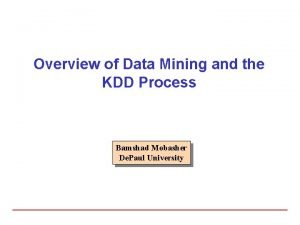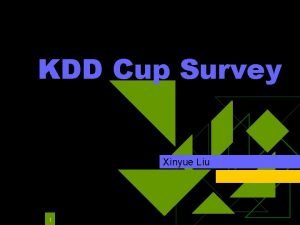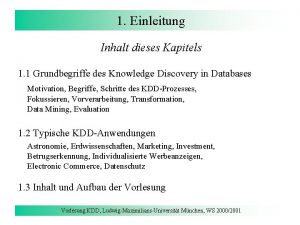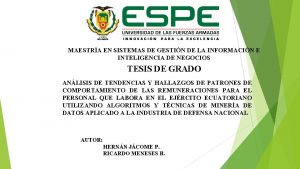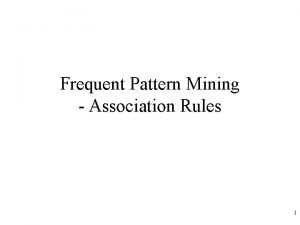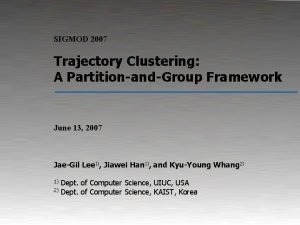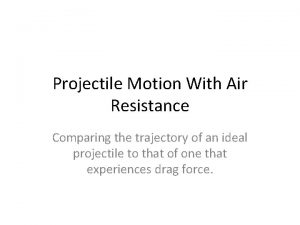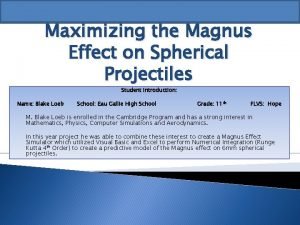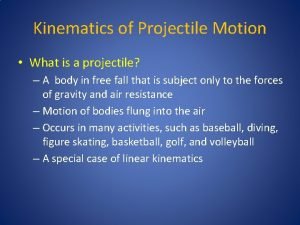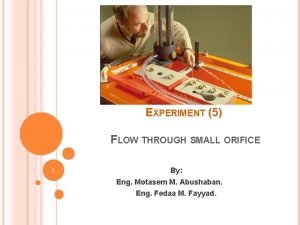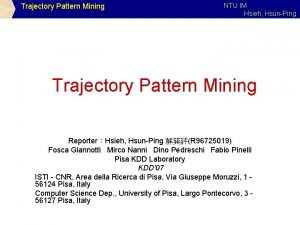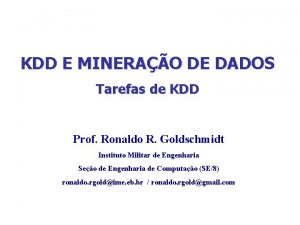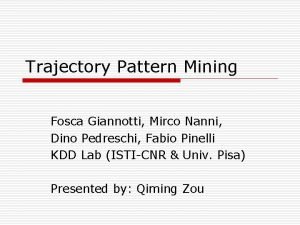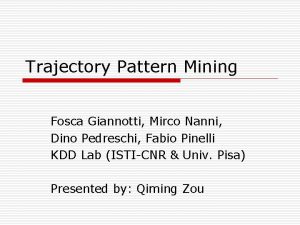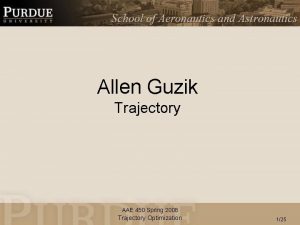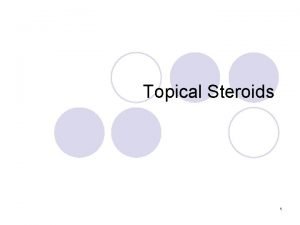TOPTRAC Topical Trajectory Pattern Mining Source KDD 2015





























- Slides: 29

TOPTRAC: Topical Trajectory Pattern Mining Source: KDD 2015 Advisor: Jia-Ling Koh Speaker: Hsiu-Yi, Chu Date: 2018/1/22

Outline Introduction Method Experient conclusion

Introduction

Introduction Goal Topical trajectory mining problem: Given a collection of geo-tagged message trajectories, it’s to find topical transition pattern and the top-k transition snippets which best represent each transition pattern

Introduction Transition pattern Transition snippet

Introduction Definition Trajectory(st) geo-tagged message (mt, i) Geo-tag Gt, i : 2 -dim vector(Gt, i, x, Gt, i, y) Bag-of-word wt, i : N words{wt, i, 1, …, wt, i, n}

Introduction Definition Latent semantic region: a geographical location where messages are posted with the same topic preference Topical transition pattern: a movement from one semantic region to another frequently

Outline Introduction Method Experience conclusion

Method Generative Model Assume there are M latent semantic regions K hidden topics in the collection of geo-tagged messages How to generate each sequence st = (mt, 1, mt, 2 , … , mt, n )

Method Generative process Ex: Θ 1=(topic 1, …topic k ) 0. 3 0. 2 0. 6 Ex: Φk=(word 1, …, word v) 0 2 3

Method mt, 1 λt : Bernoulli distribution(0~1) St, i = {0, 1}: Whether mt, i is in the local context mt, 2

Method Case 1: St, i = 1 Select Rt, i = Uniform(1/M) Generate Gt, i = Uniform(f 0) Case 2: i =1 and St, i = 1 or i >= 2 and St, i = 1 and St, i-1 = 0 Select Rt, I = Categorical(δ 0) Generate Gt, I = f(Gt, I) mt, 1 mt, 2

Method Case 3: else Select Rt, I = Categorical(δr(t, i-1), z(t, i-1)) Generate Gt, I = f(Gt, I) mt, 1 mt, 3

Method Select Topic Zt, i = Categorical(θRt, i) Select a message wt, I = Multinomial(ΦZt, i)

Method Likelihood

Method Variational EM Algorithm Maximum likelihood estimation θR, Φk, λt St, i, Rt, i, Zt, I μ r, Σ r

Method Finding the Most Likely Sequence Notations: : maximum probability to generate the subsequence when St, i=0 : : maximum probability to generate the subsequence when St, i=1

Method Compute : case 1: St, i-1 = 0 ; case 2 : St, i-1 = 1

Method Finding Frequent Transition Patterns st’ = {(st, 1, rt, 1, zt, 1), …, (st, n, rt, n, zt, n)} Transition Patterns = {( r 1, z 1)(r 2, z 2)} Start with (1, r 1, z 1) and ends with (1, r 2, z 2) τ : minimum support

Method Example s 1’={(0, 1, 1)(1, 1, 2)(1, 2, 1)}, s 2’={(1, 1, 2)(0, 2, 1)(1, 2, 1)} τ = 2 → {(1, 2)(2, 1)} is a transition pattern Top-k transition snippets k largest probabilities of with

Outline Introduction Method Experience conclusion

Experience Data sets NYC 9070 trajectories, 266808 geo-tagged messages M = 30, K = 30, τ = 100 SANF 809 trajectories, 19664 geo-tagged messages M = 20, K = 20, τ = 10

Experience Baseline LGTA Run the inference algorithm and find frequent trajectory patterns similar in page 15, 16 NAÏVE First groups messages using EM clustering Cluster the messages in each group with LDA

Experience

Experience

Experience

Experience

Outline Introduction Method Experience conclusion

Conclusion Propose a trajectory pattern mining algorithm, called TOPTRAC, using probabilistic model to capture the spatial and topical patterns of users. Developed an efficient inference algorithm for our model and also devised algorithms to find frequent transition patterns as well as the best representative snippets of each pattern.
 What is kdd process in data mining
What is kdd process in data mining Iwayback machine
Iwayback machine Trajectory data mining an overview
Trajectory data mining an overview Toptrac
Toptrac Topical pattern of arrangement
Topical pattern of arrangement Strip mining vs open pit mining
Strip mining vs open pit mining Chapter 13 mineral resources and mining worksheet answers
Chapter 13 mineral resources and mining worksheet answers Difference between strip mining and open pit mining
Difference between strip mining and open pit mining Text and web mining
Text and web mining Mining multimedia databases in data mining
Mining multimedia databases in data mining Mining complex types of data in data mining
Mining complex types of data in data mining Kdd cup 1998 solution
Kdd cup 1998 solution Kdd endikasyonları
Kdd endikasyonları Knowledge discovery process
Knowledge discovery process Kdd fayyad
Kdd fayyad Metodologia kdd
Metodologia kdd Proceso kdd
Proceso kdd Proceso kdd
Proceso kdd Association pattern mining
Association pattern mining The trajectory
The trajectory Trajectory with air resistance
Trajectory with air resistance Projectile motion equations
Projectile motion equations Range formula physics
Range formula physics Reverse magnus effect
Reverse magnus effect What is the shape of the trajectory of a projectile? *
What is the shape of the trajectory of a projectile? * Cubic polynomial trajectory matlab
Cubic polynomial trajectory matlab Radial nerve trajectory
Radial nerve trajectory Factors affecting path of a projectile
Factors affecting path of a projectile Trajectory schema examples
Trajectory schema examples Flow through an orifice lab report
Flow through an orifice lab report

